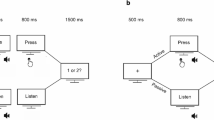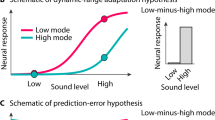Abstract
At a listener's ears, sound source power and sound source distance are confounded in measures of acoustic intensity, a physical property long thought to be the primary determinate of loudness. Although the relationship between sound source loudness and power is well known when source distance is fixed, relatively little is known about source loudness under conditions of varying distance. Here we show a robust loudness constancy, similar in many ways to visual size constancy, that results under distance-varying conditions that produce inaccurate estimates of source distance. Our results suggest that the auditory system does not require accurate distance estimates to judge source loudness, even when distance is variable. We offer an alternative explanation of loudness constancy based solely on a reverberant sound energy cue.
This is a preview of subscription content, access via your institution
Access options
Subscribe to this journal
Receive 12 print issues and online access
$209.00 per year
only $17.42 per issue
Buy this article
- Purchase on Springer Link
- Instant access to full article PDF
Prices may be subject to local taxes which are calculated during checkout





Similar content being viewed by others
References
Stevens, S. S. The measurement of loudness. J. Acoust. Soc. Am. 27, 815–829 (1955).
Hellman, R. P. in Ratio Scaling of Psychological Magnitude: In Honor of the Memory of S.S. Stevens (eds. Bolanowski, S. J., Gescheider, G. A. & Stevens, S. S.) 215–228 (Erlbaum, Hillsdale, New Jersey, 1991).
Lachs, G. A neural counting model based on physiological characteristics of the peripheral auditory system: V. Application to loudness estimation and intensity discrimination. IEEE Trans. Sys. Man Cybern. 14, 819–836 (1984).
Zwislocki, J. J. in Handbook of Mathematical Psychology (eds. Luce, R. D., Bush, R. R. & Galanter, E.) 1–97 (Wiley, New York, 1965).
Goldstein, J. L. in Sensation and Measurement—Papers in Honor of S. S. Stevens (eds. Moskowitz, H. R., Scharf, B. & Stevens, J. C.) 223–229 (Reidel, Dordrecht, 1974).
Howes, W. L. Loudness function derived from data on electrical discharge rates in auditory nerve fibers. Acustica 30, 247–259 (1974).
Mohrmann, K. Lautheitskonstanz im Entfernungswechsel. Zeitschrift für Psycologie 145, 146–199 (1939).
Fieandt, K. v. Loudness invariance in sound perception. Acta Psychologica Fennica 1, 9–20 (1951).
Shigenaga, S. The constancy of loudness and of acoustic distance. Bull. Faculty Lit. Kyushu Univ. 9, 289–333 (1965).
Allen, G. D. Acoustic level and vocal effort as cues for the loudness of speech. J. Acoust. Soc. Am. 49, 1831–1841 (1971).
Mershon, D. H., Desaulniers, D. H., Kiefer, S. A., Amerson, T. L. J. & Mills, J. T. Perceived loudness and visually-determined auditory distance. Perception 10, 531–543 (1981).
Kilpatrick, F. P. & Ittelson, W. H. The size–distance invariance hypothesis. Psychol. Rev. 60, 223–231 (1953).
Epstein, W. & Park, J. N. Shape constancy: functional relationships and theoretical formulations. Psychol. Bull. 60, 265–288 (1963).
Békésy, G. v. The moon illusion and similar auditory phenomena. Am. J. Psychol. 62, 540–552 (1949).
Holt, R. E. & Thurlow, W. R. Subject orientation and judgment of distance of a sound source. J. Acoust. Soc. Am. 46, 1584–1585 (1969).
Mershon, D. H. & Bowers, J. N. Absolute and relative cues for the auditory perception of egocentric distance. Perception 8, 311–322 (1979).
Mershon, D. H., Ballenger, W. L., Little, A. D., McMurtry, P. L. & Buchanan, J. L. Effects of room reflectance and background noise on perceived auditory distance. Perception 18, 403–416 (1989).
Nielsen, S. H. Auditory distance perception in different rooms. J. Audio Eng. Soc. 41, 755–770 (1993).
Loomis, J. M., Klatzky, R. L., Philbeck, J. W. & Golledge, R. G. Assessing auditory distance perception using perceptually directed action. Percept. Psychophys. 60, 966–980 (1998).
Bronkhorst, A. W. & Houtgast, T. Auditory distance perception in rooms. Nature 397, 517–520 (1999).
Gardner, M. B. Distance estimation of 0 degrees or apparent 0 degree-oriented speech signals in anechoic space. J. Acoust. Soc. Am. 45, 47–53 (1969).
Mershon, D. H. & King, E. Intensity and reverberation as factors in the auditory perception of egocentric distance. Percept. Psychophys. 18, 409–415 (1975).
Coleman, P. D. Dual role of frequency spectrum in determination of auditory distance. J. Acoust. Soc. Am. 44, 631–634 (1968).
Brungart, D. S. & Rabinowitz, W. M. Auditory localization of nearby sources. Head-related transfer functions. J. Acoust. Soc. Am. 106, 1465–1479 (1999).
Graziano, M. S. A., Reiss, L. A. J. & Gross, C. G. A neuronal representation of the location of nearby sounds. Nature 397, 428–430. (1999).
Stevens, S. S. & Guirao, M. Loudness, reciprocality, and partition scales. J. Acoust. Soc. Am. 34, 1466–1471 (1962).
Petersen, J. Estimation of loudness and apparent distance of pure tones in a free-field. Acustica 70, 61–65 (1990).
Da Silva, J. A. Scales for perceived egocentric distance in a large open field: comparison of three psychophysical methods. Am. J. Psychol. 98, 119–144 (1985).
Wightman, F. L. & Kistler, D. J. Headphone simulation of free-field listening: I. Stimulus synthesis. J. Acoust. Soc. Am. 85, 858–867 (1989).
Stevens, S. S. Psychophysics: Introduction to its Perceptual, Neural and Social Prospects (Wiley, New York, 1975).
Buus, S., Muesch, H. & Florentine, M. On loudness at threshold. J. Acoust. Soc. Am. 104, 399–410 (1998).
Parker, S. & Schneider, B. A. Loudness and loudness discrimination. Percept. Psychophys. 28, 398–406 (1980).
Warren, R. M. Measurement of sensory intensity. Behav. Brain Sci. 4, 175–223 (1981).
Boring, E. G. The moon illusion. Am. J. Phys. 11, 55–60 (1943).
Kaufman, L. & Rock, I. The moon illusion. Science 136, 953–961 (1962).
Rock, I. & Kaufman, L. The moon illusion. Part II. Science 136, 1023–1031 (1962).
Sedgwick, H. A. in Handbook of Perception and Human Performance (eds. Boff, K. R., Kaufman, L. & Thomas, J. P.) 21.21–21.57 (Wiley, New York, 1986).
Sabine, W. C. Collected Papers on Acoustics (Dover, New York, 1964).
Møller, H., Sørensen, M. F., Hammershøi, D. & Jensen, C. B. Head-related transfer functions of human subjects. J. Audio Eng. Soc. 43, 300–321 (1995).
Rife, D. D. & Vanderkooy, J. Transfer-function measurement with maximum-length sequences. J. Audio Eng. Soc. 37, 419–444 (1989).
Carlson, V. R. in Stability and Constancy in Visual Perception: Mechanisms and Processes (ed. Epstein, W.) 217–254 (Wiley, New York, 1977).
ISO 226. Acoustics—Normal Equal-Loudness Contours (International Organization for Standardization, Geneva, 1987).
Acknowledgements
Financial support for this work was provided by the NIH-NIDCD (DC00116), NIH-NEI (1F32EY07010-01), and NASA (Cooperative Agreement #NCC2-542). The authors wish to thank J. Loomis for discussions on perceptual constancy and comments on this article.
Author information
Authors and Affiliations
Corresponding author
Rights and permissions
About this article
Cite this article
Zahorik, P., Wightman, F. Loudness constancy with varying sound source distance. Nat Neurosci 4, 78–83 (2001). https://doi.org/10.1038/82931
Received:
Accepted:
Issue Date:
DOI: https://doi.org/10.1038/82931
This article is cited by
-
Experimental Approaches to Studies of the Localization of Sound Sources by Distance
Neuroscience and Behavioral Physiology (2024)
-
Back and front peripersonal space: behavioural and EMG evidence of top–down and bottom–up mechanisms
Experimental Brain Research (2024)
-
Shaping the auditory peripersonal space with motor planning in immersive virtual reality
Virtual Reality (2023)
-
Effective sound detection system in commercial car vehicles using Msp430 launchpad development
Multimedia Tools and Applications (2023)
-
Partial visual loss disrupts the relationship between judged room size and sound source distance
Experimental Brain Research (2022)



